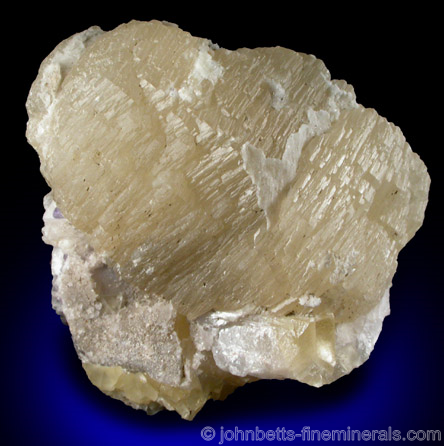The Mineral witherite

Witherite is an uncommon mineral, especially since it easily alters to the more common mineral Barite. It alters when sulfuric acid from sulfide minerals dissolves the Witherite, and the sulfur combines with the barium to form Barite. Witherite is also formed from Calcite that loses its calcium, and gets replaced by barium, thus forming Witherite in the process.
Witherite was named by Abraham Gottlob Werner in honor of William Withering (1741-1799), an English geologist, chemist, botanist, and physician. Withering is credited with the identification of this mineral as a separate species from Barite.
Color
White, cream, grayish-white, pale yellow, pale green
Crystal System
Orthorhombic
Properties
Streak
White |
Hardness
3 - 3.5 |
Transparency
Transparent to translucent |
Specific Gravity
4.3 - 4.6 |
Luster
Vitreous |
Cleavage
3,1 - prismatic |
Fracture
Uneven |
Tenacity
Brittle |
Other ID Marks
Fluorescent whitish-blue in shortwave ultraviolet light. |
Crystal Habits
Crystals are always almost always twinned, usually in pseudohexagonal trillings that are bipyramidal, resembling bipyramidal hexagons. Crystals may also be elongated pseudohexagonal trillings that are not bipyramidal, and are usually scepter shaped. May also be in bladed or tabular crystals. Most crystals have striations on crystals faces, which sometimes may be deep indentations. Witherite also occurs fibrous, grainy, platy, mammilary, columnar, crusty, massive, and as groups of crystals in layers.
Uses
Witherite is used in the production of glass. Good crystals of this mineral are highly desirable among collectors.
Noteworthy Localities
There are not many significant localities for Witherite. The two most noteworthy localities are are the deposits in Alston Moor, North Pennines, Cumbria, England; and the Minerva No. 1 Mine, Cave-in-Rock, Hardin Co., Illinois. Other occurrences are the Fallowfield and Settlingstones Mines, Acomb, near Hexham, Northumberland, England; the Pigeon Roost Mine, Glenwood, Montgomery Co., Arkansas; El Portal, Mariposa Co., California; and Thunder Bay, Ontario, Canada.
Distingushing Similar Minerals
Strontianite and Aragonite- Lighter in weight.
Cerussite - Heavier, exhibits better cleavage.
Weloganite - Occurs in a different mineral locality.